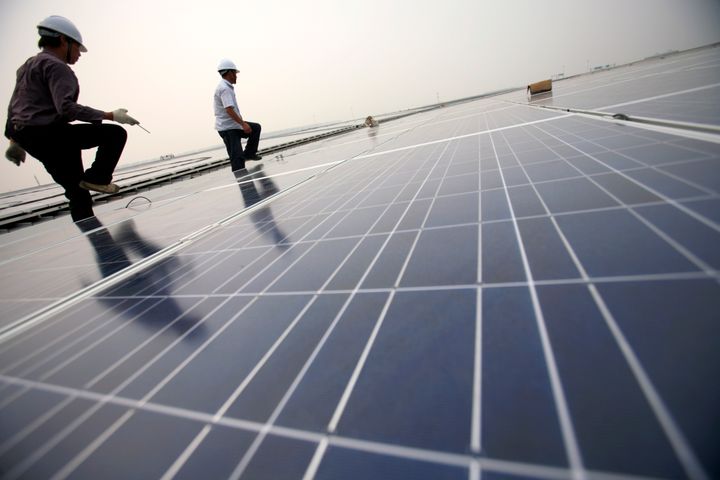
By Cody Knipfer
Every hour, Chinese workers install an array of solar panels at least the size of a soccer field. Already home to the world’s largest solar plant and floating solar installation, over half of the world’s current construction on solar power installations is taking place in China. Despite its longstanding reputation as a smog-blanketed polluter, China today stands at the top of global investment in, and production and exports of, solar panels and other renewable energy systems. For those familiar with China’s global economic strategy, this development should raise eyebrows.
Driven by the quickly dropping costs of manufacturing and using renewables, particularly solar energy, global interest in renewable energy and energy efficiency technologies is on the rise. This presents an opportunity for the leading manufacturers and exporters of renewable energy systems to gain a solid economic foothold abroad – and reap the political influence that comes with it. China is successfully harnessing this potential in solar power, accelerating its foreign investment and capturing significant dominance in the market. Meanwhile others, such as the United States, are falling behind.
China’s lead in renewables cannot be ignored. Dominance in clean energy exports feeds into the country’s geopolitical efforts to carve out leadership in the global economic order. Through a strategy of “economic diplomacy,” which involves strong trade partnerships and foreign reliance on its investment and sales, China’s economic and regional rise is strengthened and safeguarded. Bankrolling clean-energy projects across the developing world – in Asia, Africa, and Eastern Europe – gives China an edge, pushing countries to buy from Chinese companies and turn to Chinese leadership in the quest to achieve their energy and climate goals. These investments, in turn, bolster deeper cooperation on other infrastructure projects and development goals between China and its trade partners.
This has substantial implications for the United States. Policymakers must keep in mind that China’s preeminence in renewables supports a strategy where Chinese economic and geopolitical gains come at the United States’ expense. Abdicating a lead in clean energy to this major competitor accordingly risks the United States’ long-term prospects as an energy powerhouse and leader in the global economic order. Coupled with its retreat from sustainable climate goals, the United States has opened a vacuum in economic and normative leadership that rising powers, such as China, are all the more willing and able to fill.
With Chinese investment in clean energy showing no signs of abating, the United States must aggressively pursue policies to develop a strong domestic manufacturing and export capability for renewables and integrate itself into this emerging energy sector of critical future importance. In effect, it needs to play catch up. This is a strategically significant goal, considering the long-term global shift toward renewables away from traditional energy sources, such as natural gas, where the United States currently leads.
How can it do so? For now, policymakers should start by focusing on combating the abundance of cheaply imported solar panels in the American market: establishing a fair domestic market is the first step toward becoming competitive. Today, the US solar industry largely relies on subsidized solar panels from abroad to drive electricity costs down. These imports are the largest obstacle to American competitiveness in domestic manufacturing – undercutting the market for American-made panels and forcing American producers out of business. To limit their abundance, the United States and other countries have instated large tariffs against their import, especially from China.
This, however, presents a difficult “catch-22.” Because of these imports driving down costs, the United States’ solar sales sector is booming, with purchases of renewable-derived energy on the rise. Many in the US solar industry oppose tariffs, arguing they will send the costs of solar soaring and reverse the sector’s high-growth trajectory. It doesn’t help, either, that the Trump Administration has threatened deep cuts to federal research funding for solar technology.
A reasonable balance can be struck. If higher tariffs are the answer to ensuring a level playing field for American manufacturers, they should be pursued alongside policies to offset cost increases – such as tax credits and deductions – for both solar panel operators and the electricity consumer. And if not, the Trump Administration needs to strongly consider reversing course on cutting federal funding for research and development that sparks innovation in solar technology.
Ultimately, the future of American energy competitiveness – and, in turn, future economic and geopolitical leadership – is at stake. The solar revolution is powering China’s rise; it can, and should, do the same for the United States.
Cody Knipfer is the Technology & Cybersecurity Fellow at Young Professionals in Foreign Policy (YPFP). He has experience working with space and aerospace trade associations, as well as a space policy consultancy. Cody expects to receive his MA in International Science and Technology Policy in 2018 from George Washington University's Space Policy Institute.
